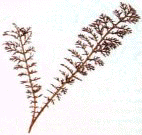|


Also call:
Bloodwort, Knight's Milfoil, Military herb, Nose Bleed, Old Man's Pepper,
Sanguinary, Soldier's Woundwort, Staunchweed
 | DESCRIPTION
|
Yarrow can grows up to 60cm in height,
has foliage that are thickly matted and feathery with roots that spread. In
the summer and autumn season, little small white flowers blooms and the
flower heads erect on top in 60cm tall.
 | HISTORY AND ORIGIN
|
According to Europe and Britain, Yarrow
is a wild plant. The legend name was referred to the Achilles which
they used it to staunch the blood of his wounded soldiers. It was
believed to have improved strength and stamina, and the other names of the
Yarrow which shows the same usage of this herb as a first aid for wound in
the past centuries.
 | BUYING AND STORAGE
|
Fresh Yarrow are best put in water and
keep in the refrigerator for about 4 days. Yarrow are best eaten fresh
from the garden when picked and to be use immediately. Dried Yarrow
are available through the herbalists and are thought best as a medicinal
than using it as food.
 | PREPARATION AND USE
|
Although the Yarrow leaves have a
pleasant, slightly bitter taste which can be eaten as a vegetable by
steaming it gently. Can be added into soups and salads by chopping it
finely. Yarrow can be use to make a refreshing tea by mixing an equal
amount of chamomile or peppermint to it.
|




